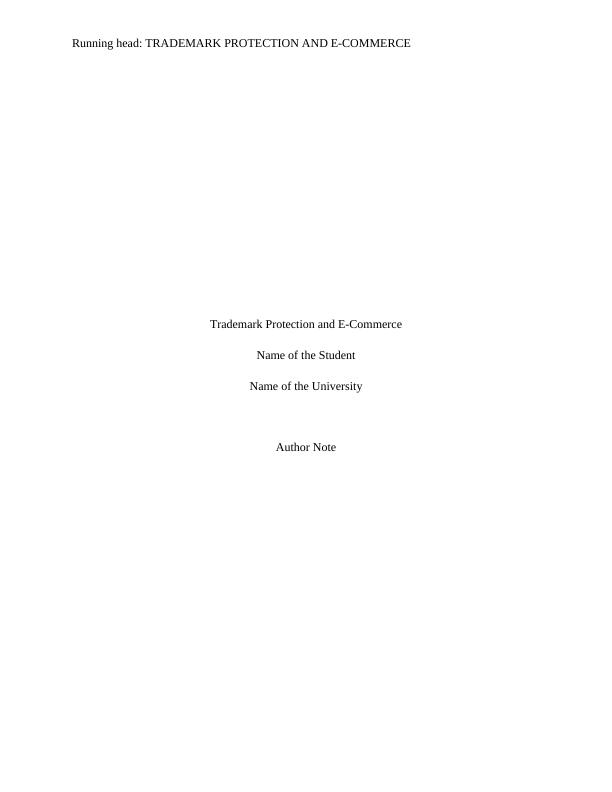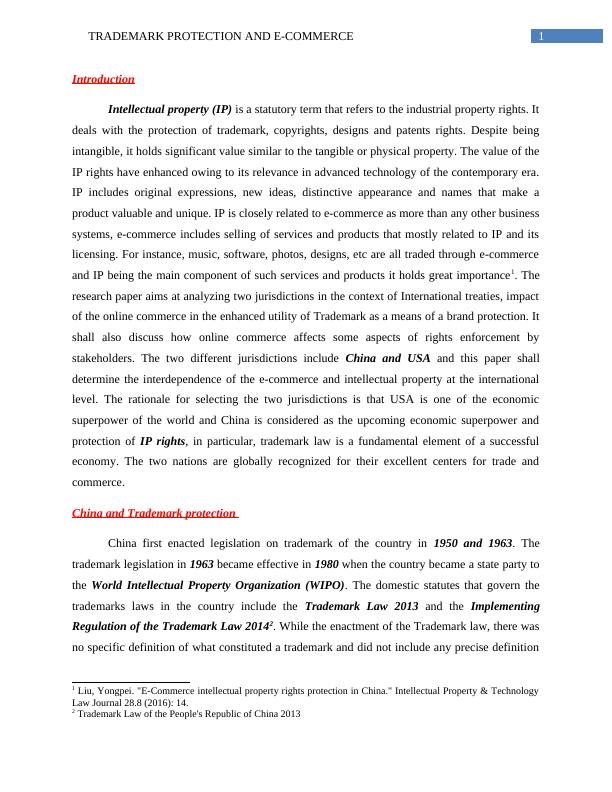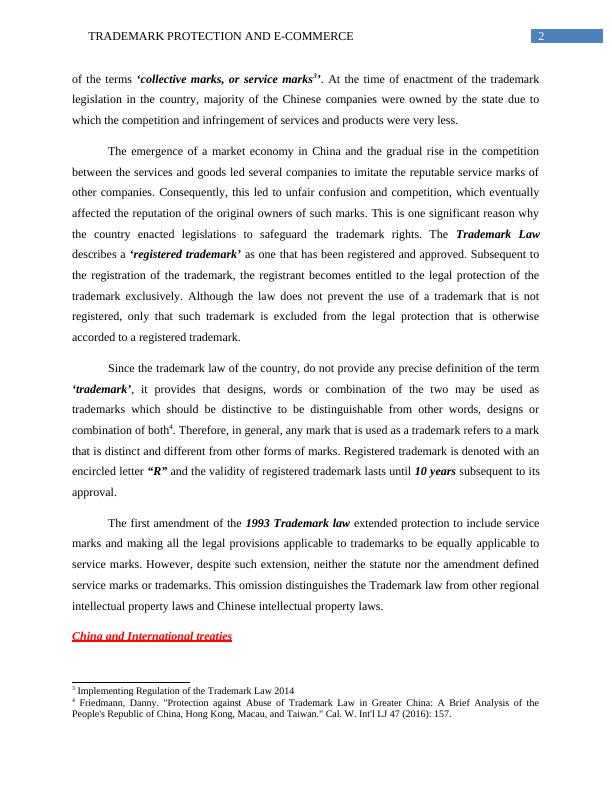Trademark Protection and E-Commerce
Added on 2023-06-14
16 Pages6189 Words320 Views
Running head: TRADEMARK PROTECTION AND E-COMMERCE
Trademark Protection and E-Commerce
Name of the Student
Name of the University
Author Note
Trademark Protection and E-Commerce
Name of the Student
Name of the University
Author Note

1TRADEMARK PROTECTION AND E-COMMERCE
Introduction
Intellectual property (IP) is a statutory term that refers to the industrial property rights. It
deals with the protection of trademark, copyrights, designs and patents rights. Despite being
intangible, it holds significant value similar to the tangible or physical property. The value of the
IP rights have enhanced owing to its relevance in advanced technology of the contemporary era.
IP includes original expressions, new ideas, distinctive appearance and names that make a
product valuable and unique. IP is closely related to e-commerce as more than any other business
systems, e-commerce includes selling of services and products that mostly related to IP and its
licensing. For instance, music, software, photos, designs, etc are all traded through e-commerce
and IP being the main component of such services and products it holds great importance1. The
research paper aims at analyzing two jurisdictions in the context of International treaties, impact
of the online commerce in the enhanced utility of Trademark as a means of a brand protection. It
shall also discuss how online commerce affects some aspects of rights enforcement by
stakeholders. The two different jurisdictions include China and USA and this paper shall
determine the interdependence of the e-commerce and intellectual property at the international
level. The rationale for selecting the two jurisdictions is that USA is one of the economic
superpower of the world and China is considered as the upcoming economic superpower and
protection of IP rights, in particular, trademark law is a fundamental element of a successful
economy. The two nations are globally recognized for their excellent centers for trade and
commerce.
China and Trademark protection
China first enacted legislation on trademark of the country in 1950 and 1963. The
trademark legislation in 1963 became effective in 1980 when the country became a state party to
the World Intellectual Property Organization (WIPO). The domestic statutes that govern the
trademarks laws in the country include the Trademark Law 2013 and the Implementing
Regulation of the Trademark Law 20142. While the enactment of the Trademark law, there was
no specific definition of what constituted a trademark and did not include any precise definition
1 Liu, Yongpei. "E-Commerce intellectual property rights protection in China." Intellectual Property & Technology
Law Journal 28.8 (2016): 14.
2 Trademark Law of the People's Republic of China 2013
Introduction
Intellectual property (IP) is a statutory term that refers to the industrial property rights. It
deals with the protection of trademark, copyrights, designs and patents rights. Despite being
intangible, it holds significant value similar to the tangible or physical property. The value of the
IP rights have enhanced owing to its relevance in advanced technology of the contemporary era.
IP includes original expressions, new ideas, distinctive appearance and names that make a
product valuable and unique. IP is closely related to e-commerce as more than any other business
systems, e-commerce includes selling of services and products that mostly related to IP and its
licensing. For instance, music, software, photos, designs, etc are all traded through e-commerce
and IP being the main component of such services and products it holds great importance1. The
research paper aims at analyzing two jurisdictions in the context of International treaties, impact
of the online commerce in the enhanced utility of Trademark as a means of a brand protection. It
shall also discuss how online commerce affects some aspects of rights enforcement by
stakeholders. The two different jurisdictions include China and USA and this paper shall
determine the interdependence of the e-commerce and intellectual property at the international
level. The rationale for selecting the two jurisdictions is that USA is one of the economic
superpower of the world and China is considered as the upcoming economic superpower and
protection of IP rights, in particular, trademark law is a fundamental element of a successful
economy. The two nations are globally recognized for their excellent centers for trade and
commerce.
China and Trademark protection
China first enacted legislation on trademark of the country in 1950 and 1963. The
trademark legislation in 1963 became effective in 1980 when the country became a state party to
the World Intellectual Property Organization (WIPO). The domestic statutes that govern the
trademarks laws in the country include the Trademark Law 2013 and the Implementing
Regulation of the Trademark Law 20142. While the enactment of the Trademark law, there was
no specific definition of what constituted a trademark and did not include any precise definition
1 Liu, Yongpei. "E-Commerce intellectual property rights protection in China." Intellectual Property & Technology
Law Journal 28.8 (2016): 14.
2 Trademark Law of the People's Republic of China 2013

2TRADEMARK PROTECTION AND E-COMMERCE
of the terms ‘collective marks, or service marks3’. At the time of enactment of the trademark
legislation in the country, majority of the Chinese companies were owned by the state due to
which the competition and infringement of services and products were very less.
The emergence of a market economy in China and the gradual rise in the competition
between the services and goods led several companies to imitate the reputable service marks of
other companies. Consequently, this led to unfair confusion and competition, which eventually
affected the reputation of the original owners of such marks. This is one significant reason why
the country enacted legislations to safeguard the trademark rights. The Trademark Law
describes a ‘registered trademark’ as one that has been registered and approved. Subsequent to
the registration of the trademark, the registrant becomes entitled to the legal protection of the
trademark exclusively. Although the law does not prevent the use of a trademark that is not
registered, only that such trademark is excluded from the legal protection that is otherwise
accorded to a registered trademark.
Since the trademark law of the country, do not provide any precise definition of the term
‘trademark’, it provides that designs, words or combination of the two may be used as
trademarks which should be distinctive to be distinguishable from other words, designs or
combination of both4. Therefore, in general, any mark that is used as a trademark refers to a mark
that is distinct and different from other forms of marks. Registered trademark is denoted with an
encircled letter “R” and the validity of registered trademark lasts until 10 years subsequent to its
approval.
The first amendment of the 1993 Trademark law extended protection to include service
marks and making all the legal provisions applicable to trademarks to be equally applicable to
service marks. However, despite such extension, neither the statute nor the amendment defined
service marks or trademarks. This omission distinguishes the Trademark law from other regional
intellectual property laws and Chinese intellectual property laws.
China and International treaties
3 Implementing Regulation of the Trademark Law 2014
4 Friedmann, Danny. "Protection against Abuse of Trademark Law in Greater China: A Brief Analysis of the
People's Republic of China, Hong Kong, Macau, and Taiwan." Cal. W. Int'l LJ 47 (2016): 157.
of the terms ‘collective marks, or service marks3’. At the time of enactment of the trademark
legislation in the country, majority of the Chinese companies were owned by the state due to
which the competition and infringement of services and products were very less.
The emergence of a market economy in China and the gradual rise in the competition
between the services and goods led several companies to imitate the reputable service marks of
other companies. Consequently, this led to unfair confusion and competition, which eventually
affected the reputation of the original owners of such marks. This is one significant reason why
the country enacted legislations to safeguard the trademark rights. The Trademark Law
describes a ‘registered trademark’ as one that has been registered and approved. Subsequent to
the registration of the trademark, the registrant becomes entitled to the legal protection of the
trademark exclusively. Although the law does not prevent the use of a trademark that is not
registered, only that such trademark is excluded from the legal protection that is otherwise
accorded to a registered trademark.
Since the trademark law of the country, do not provide any precise definition of the term
‘trademark’, it provides that designs, words or combination of the two may be used as
trademarks which should be distinctive to be distinguishable from other words, designs or
combination of both4. Therefore, in general, any mark that is used as a trademark refers to a mark
that is distinct and different from other forms of marks. Registered trademark is denoted with an
encircled letter “R” and the validity of registered trademark lasts until 10 years subsequent to its
approval.
The first amendment of the 1993 Trademark law extended protection to include service
marks and making all the legal provisions applicable to trademarks to be equally applicable to
service marks. However, despite such extension, neither the statute nor the amendment defined
service marks or trademarks. This omission distinguishes the Trademark law from other regional
intellectual property laws and Chinese intellectual property laws.
China and International treaties
3 Implementing Regulation of the Trademark Law 2014
4 Friedmann, Danny. "Protection against Abuse of Trademark Law in Greater China: A Brief Analysis of the
People's Republic of China, Hong Kong, Macau, and Taiwan." Cal. W. Int'l LJ 47 (2016): 157.

3TRADEMARK PROTECTION AND E-COMMERCE
China is a signatory to the following IP-related international treaties include the Madrid
Agreement, the Madrid Protocol, the Berne Convention, the Nice Agreement, the Agreement
on Trade-related Aspects of Intellectual Property Rights and the Paris Convention5. In case of
any dispute, international treaties shall prevail over the national statutes6. The country agreed to
the international treaties to strengthen the trademark laws of the country especially the Madrid
Agreement Concerning the International Registration of Marks (Madrid Agreement) and the
International Convention for the Protection of Industrial property (Paris Convention) in
19897. However, Turban (2018) states that despite persisting broadcast by the country of his
intellectual property laws and assenting to international treaties, the trademark laws of the
country failed to provide sufficient protection to the trademark rights8. Further, there is sufficient
evidence to establish that China failed to provide maximum benefits to the foreigners from its
membership in those Foreign or International conventions9.
United States and International treaties on Trademark protection
While the agreement of the country with the Paris Convention obligated China to
safeguard service marks, there were no such methods implemented until the trademark laws was
amended in 1993. Giuffrida (2017) states that as per a US trade organization, the International
Intellectual Property Alliance estimated that the country has caused a loss of $415 million to the
US industries due to the failure of the county to safeguard US intellectual property adequately
which resulted in sale of printed goods in the year 1988. In 1991, the US government decided
that the country warranted a Special 301 investigation under Title III of the Trade Act of 1974
for its failure to implement intellectual property protections.
In order to prevent further loss in US businesses, United States and China signed a
Memorandum of Understanding (MOU) in January 1992 whereby both countries agreed to
make the laws on infringement of intellectual property rights. Later, the United States agreed to
terminate the Special 301 investigations and removed China from its list of priority countries.
The Chinese legislators considered amendment of the trademark law to address issues pertaining
5 International Convention for the Protection of Industrial property (Paris Convention) 1989
6 Madrid Agreement Concerning the International Registration of Marks (Madrid Agreement).
7 The Protocol Relating to the Madrid Agreement Concerning the International Registration of Marks (Madrid
Protocol)
8 The Nice Agreement 1957.
9 Carpenter, Megan M. "Trademark Law Promotes Fair Competition, Not Morality." (2016).
China is a signatory to the following IP-related international treaties include the Madrid
Agreement, the Madrid Protocol, the Berne Convention, the Nice Agreement, the Agreement
on Trade-related Aspects of Intellectual Property Rights and the Paris Convention5. In case of
any dispute, international treaties shall prevail over the national statutes6. The country agreed to
the international treaties to strengthen the trademark laws of the country especially the Madrid
Agreement Concerning the International Registration of Marks (Madrid Agreement) and the
International Convention for the Protection of Industrial property (Paris Convention) in
19897. However, Turban (2018) states that despite persisting broadcast by the country of his
intellectual property laws and assenting to international treaties, the trademark laws of the
country failed to provide sufficient protection to the trademark rights8. Further, there is sufficient
evidence to establish that China failed to provide maximum benefits to the foreigners from its
membership in those Foreign or International conventions9.
United States and International treaties on Trademark protection
While the agreement of the country with the Paris Convention obligated China to
safeguard service marks, there were no such methods implemented until the trademark laws was
amended in 1993. Giuffrida (2017) states that as per a US trade organization, the International
Intellectual Property Alliance estimated that the country has caused a loss of $415 million to the
US industries due to the failure of the county to safeguard US intellectual property adequately
which resulted in sale of printed goods in the year 1988. In 1991, the US government decided
that the country warranted a Special 301 investigation under Title III of the Trade Act of 1974
for its failure to implement intellectual property protections.
In order to prevent further loss in US businesses, United States and China signed a
Memorandum of Understanding (MOU) in January 1992 whereby both countries agreed to
make the laws on infringement of intellectual property rights. Later, the United States agreed to
terminate the Special 301 investigations and removed China from its list of priority countries.
The Chinese legislators considered amendment of the trademark law to address issues pertaining
5 International Convention for the Protection of Industrial property (Paris Convention) 1989
6 Madrid Agreement Concerning the International Registration of Marks (Madrid Agreement).
7 The Protocol Relating to the Madrid Agreement Concerning the International Registration of Marks (Madrid
Protocol)
8 The Nice Agreement 1957.
9 Carpenter, Megan M. "Trademark Law Promotes Fair Competition, Not Morality." (2016).

End of preview
Want to access all the pages? Upload your documents or become a member.
Related Documents
IP PROTECTION AND REGULATION.. IP Protection and Regulation Namelg...
|19
|5739
|1
Database Legal Protection (pdf)lg...
|6
|948
|127
Competition Law Assignmentlg...
|14
|3812
|82
Advanced Intellectual Property Lawlg...
|10
|2272
|324
The African Katempfe Berry Intellectual Property Law Assignmentlg...
|17
|4025
|476
International Intellectual Property Lawlg...
|18
|4244
|4
